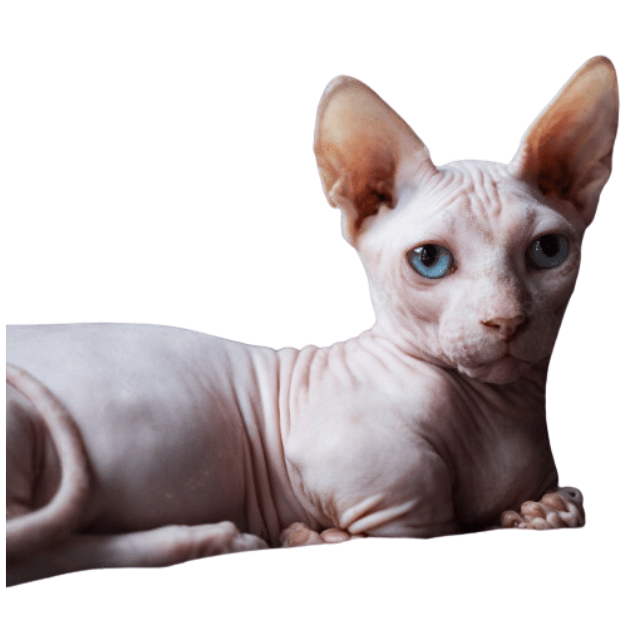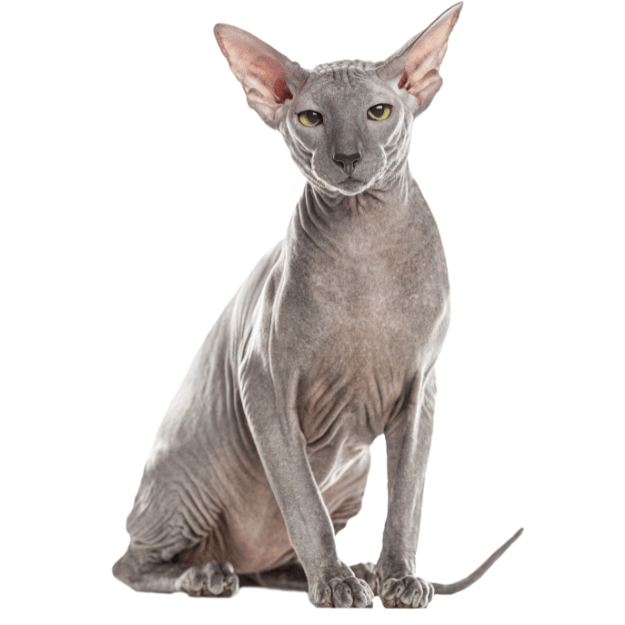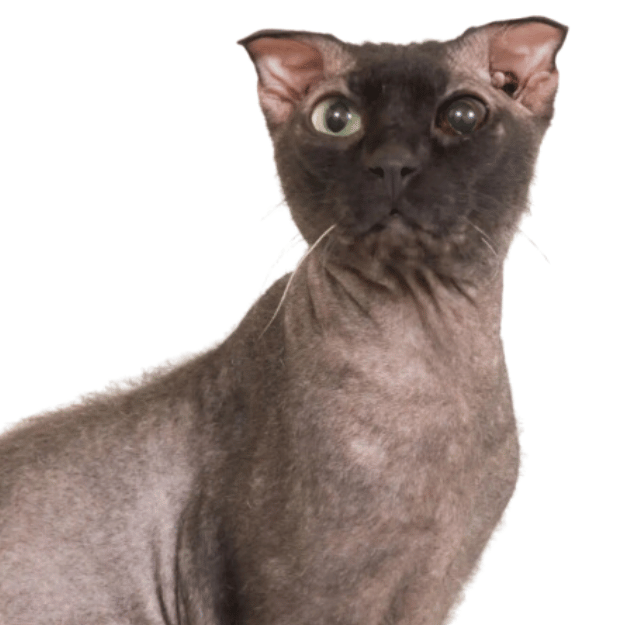This post contains affiliate links and I will be compensated if you make a purchase after clicking on my links.
The Intriguing World of Hairless Cat Breeds
Hairless cat breeds, resulting from genetic mutations that remove fur, present an exotic and eye-catching appearance. These breeds may vary from having soft, downy fuzz to being completely hairless. Despite their bald look, which might seem low-maintenance, they require considerable care.
Lacking fur to absorb body oils, these cats accumulate oil quickly, making regular bathing crucial to prevent skin issues. They also need protection from environmental extremes, being highly susceptible to sunburn and cold due to their exposed skin.
Owners must take proactive measures, such as applying sunscreen, using UV window filters, providing cooling mats in summer, and dressing them in cozy sweaters during colder months.
This dedicated grooming and care ensure their health and comfort, making the extra effort worthwhile for lovers of these distinctively charming and bald beauties.
Spotlight on Eight Popular Hairless Cats
1. Sphynx

The Sphynx is perhaps the most famous of all hairless cat breeds. Originating in Canada in the 1960s due to a genetic mutation, the Sphynx is covered with a very fine layer of down, giving it a soft feel to the touch rather than a completely bald appearance.
Known for their extroverted and energetic personalities, Sphynx cats are often described as part dog, part child, and part monkey, due to their lively antics and love for human attention. They communicate with distinctive vocalizations, making them a vocal member of any household.
2. Bambino

The Bambino, a cross between a Sphynx and a Munchkin, emerged in 2005. These cats inherit the hairlessness of the Sphynx and the short stature of the Munchkin, leading to their name ‘Bambino’, which means ‘baby’ in Italian.
As an experimental breed not yet officially recognized by cat fancier associations, Bambinos capture hearts with their kitten-like appearance throughout their lives. However, potential owners should be aware of the possible joint issues associated with their dwarfism.
3. Peterbald

Originating from Russia, the Peterbald is a blend of the hairless Donskoy and the elegant Oriental Shorthair. This breed exhibits a range of coat types, from bald to a fine fuzz, and even some with curly or wiry hair.
Peterbalds are known for their affectionate nature and loyalty, often forming strong bonds with their families. Their striking appearance, highlighted by large, set ears and a slim build, makes them a standout breed both in looks and personality.
4. Donskoy (Don Sphynx)

The Donskoy, also known as the Russian Hairless, Don Hairless, or Don Sphynx, carries a dominant gene for hairlessness. This sets it apart from breeds like the Sphynx, which has a recessive gene for the trait, ensuring consistent inheritance among offspring.
Originating in Russia, the Donskoy showcases a muscular build and can exhibit various skin textures, ranging from completely bald to a soft, velvety peach fuzz. They come in four coat varieties:
- Rubber Bald: Born bald and remains so.
- Flocked: Has downy, peach-fuzz that may eventually shed.
- Velour: Born with a bald spot on the head.
- Brush: Features bald spots across their coat.
Their combination of smarts and sweet disposition makes them both delightful companions and easy to train.
5. Lykoi

Also known as the werewolf cat, the Lykoi sports a sparse coat that periodically molts in a process affectionately termed “wolfing out.” While their fur is incredibly soft and enhances their appeal during cuddle sessions, owning such a unique cat comes with its costs; Lykoi kittens typically start around $1,000.
They are sociable with humans and other pets, making them ideal companions for households with existing pets. The Lykoi’s coat varies significantly, ranging from a distinctive black-gray coverage to predominantly hairless, showcasing their unique genetic traits.
6. Ukrainian Levkoy

The Ukrainian Levkoy, recognized for its distinctive inward-folding ears reminiscent of the Scottish Fold, was developed through a cross between Donskoys and Scottish Folds.
This breed features an angular, wrinkled face that adds to its unique charm. Although a newcomer in the cat world, having been established in 2004, the Ukrainian Levkoy is celebrated for its gentle and serene demeanor, often preferring the quiet companionship of its family.
Like its Scottish cousin, the Ukrainian Levkoy may face similar health challenges related to joint and cartilage issues, a concern still under study given the breed’s recent emergence.
7. Dwelf

The Dwelf cat is a striking blend of several breeds, inheriting traits from the Munchkin, American Curl, and Sphynx. This results in a cat with compact, dwarf-like features, large curled ears, and a lack of fur.
The name “Dwelf,” a combination of “dwarf” and “elf,” aptly reflects their enchanted appearance. These cats are known for their sociable and affectionate behavior, thriving on interaction with their human families. Due to their mixed genetic heritage, Dwelfs may face various health challenges, including skeletal issues, necessitating vigilant veterinary care.
8. Minskin

The Minskin, a hybrid breed from the Munchkin, Burmese, Sphynx, and Devon Rex, features a small to medium-sized muscular body with a semi-cobby build.
This breed is distinguished by its rounded head, large ears that are wide at the base, and a short, broad muzzle with pronounced whisker pads. Their large, round eyes are set widely apart, giving them an alert and engaging appearance.
Minskins sport a unique coat pattern with denser “fur points” on their mask, ears, legs, and tail, and a sparser, cashmere-like covering on the torso. Developed in the early 2000s, these cats are known for their friendly, outgoing nature and a tendency to be the center of attention.
Are Hairless Cats Hypoallergenic? Debunking the Myth
One common question among potential cat owners is whether hairless cats are hypoallergenic. While it’s a prevalent notion, it’s crucial to understand that no cat is completely hypoallergenic.
Hairless cats do tend to produce fewer allergens than their furry counterparts because they don’t shed fur, but they still produce dander and proteins in their saliva and urine that can trigger allergies. For individuals sensitive to allergens, hairless cats might seem like a suitable option, but it’s important to spend time around the breed before making a decision.
Tip: Hairless cats don’t shed fur, but their shedding of dead skin can still trigger allergies, requiring careful grooming to manage these potential allergens.
Conclusion: Is a Hairless Cat Right for You?
Choosing to welcome a hairless cat into your home comes with unique considerations. Their striking appearance and engaging personalities can make them wonderful companions, but they also require specific care and attention to keep them healthy and happy.
From special grooming needs to health considerations, prospective owners must be prepared for the added responsibilities that come with these breeds. If you’re looking for a pet that stands out from the crowd and are willing to invest time in their care, a hairless cat could be a perfect addition to your family.
Ready to gear up for your sleek, chic fur-less friend? Visit our Hairless Cat Products Page to find everything you need—from ultra-moisturizing shampoos to the coziest of sun-blocking sweaters. Let’s make your hairless companion as pampered and tech-savvy as they deserve!
Meet Sean, a fintech whiz with a penchant for pet purrs and blockchain buzz. After a decade of fintech feats, Sean’s tech talents leaped from ledger lines to litter lines, driven by a passion for pets and a vision for a more connected pet care community. With three critter companions as co-pilots, Sean launched this blog to share a treasury of pet-friendly tech tips and tales.



